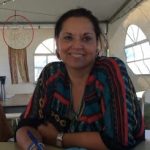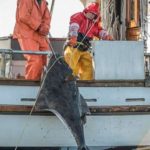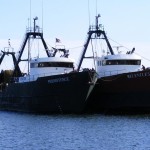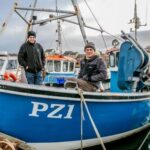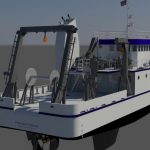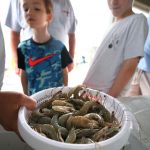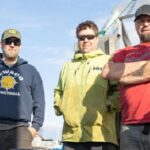Tag Archives: Northeast Fisheries Science Center
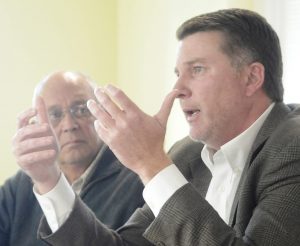
Lobster industry blasts proposed regulations intended to protect whales
Maine officials and members of the state’s lobster industry are blasting a new federal report on the endangered right whale, claiming it uses old science to unfairly target the fishery for restrictions.
The Maine Department of Marine Resources, the agency that regulates the $434 million lobster fishery, and the Maine Lobstermen’s Association, the trade group representing Maine’s 4,500 active commercial lobstermen, question the scientific merits of the report from the Northeast Fisheries Science Center, which was issued in advance of next week’s meeting of a federal right whale protection advisory team. “They’re painting a big target on the back of the Maine lobster industry, but the picture isn’t based on the best available science,” DMR Commissioner Patrick Keliher said Thursday. >click to read<09:34
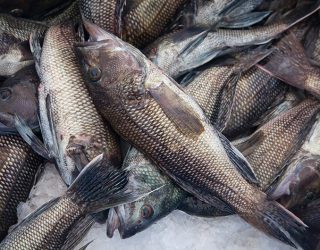
Scientists say black Sea bass behavior could be affected by offshore wind
Scientists from the Northeast Fisheries Science Center say that offshore wind energy construction could affect the behavior of Black Sea Bass. Black Sea Bass live up and down the east coast from Maine to the Gulf of Mexico, providing a significant ecological and economic importance. The fish are also attracted to structurally complex habitats, often found around rocky reefs, mussel beds, cobble and rock fields, and artificial habitats like shipwrecks. Scientists, commercial and recreational fisherman have expressed their concerns about how the sounds that come with the development of offshore wind energy overlapping with the natural habitats of Black Sea Bass. >click to read<09:37
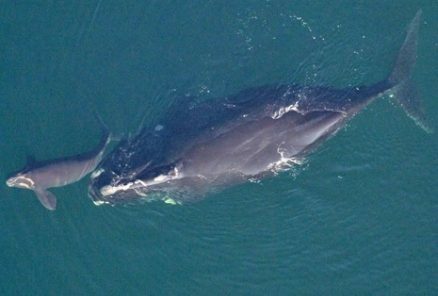
NOAA findings on right whale endangerment could affect lobster fishery
A new report by the National Oceanic and Atmospheric Administration’s Northeast Fisheries Science Center finds that the decline of the North Atlantic right whale population over the past eight years is due to multiple factors that include entanglement with fishing gear. The whales’ range expansion has exposed them to vessel traffic and fisheries in Canadian waters, which did not have protections for right whales in place until late last summer, the report says. Lobster populations are also changing distribution in the Gulf of Maine, causing U.S. fisheries to move farther offshore in pursuit of lobsters, thus increasing overlap between fishing activity and right whale foraging areas and migration corridors. >click to read<14:30
NEFMC Seeks Input From Fishermen and Research Partners on RSA Programs; Take the Online Survey!
The New England Fishery Management Council is asking fishermen and their cooperative research partners who participate in the Atlantic Sea Scallop, Atlantic Herring, and/or Monkfish Research Set-Aside (RSA) Programs to take an online survey and provide feedback on the strengths and weaknesses of these programs and pass along any suggestions for improvement. Other stakeholders who have an interest or role in RSA programs also are encouraged to take the survey.,,, The survey, which contains roughly 40 questions, will be available online until mid-September 2018. >click to read<17:02
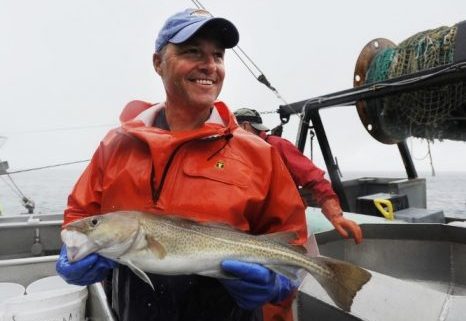
Study: Ocean noise may hinder fish mating
The party is noisy. The music and conversation drown out what you want to say. Welcome to the world of the cod, haddock and other fishwhere its considerably harder because its done in the dark, 160 feet below the ocean surface, where vital communication – essrtially “Here I am, over here!”- can be lost at the constant roar of ships passing overhead, An increasingly noisy ocean may mean fish are having a hard time finding one another to spawn and navigate, according to a new study by NOAA scientists and published last month in the online journal Scientific Reports by Nature. click here to read the story 10:28

New NOAA Director seems willing to work with fishing industry
Jon Hare has just completed his first twelve months on the job as a science and research director or NOAA’s Northeast Fisheries Science Center in Woods Hole. And its a big job. But he’s still smiling. The NEFSC managers the living marine resources of the Northeast Continental Shelf Ecosystem from the Gulf of Maine to Cap Hatteras. But Hare’s energy and enthusiasm have been equal to the task, while his willingness to listen and engage with all comers have earned him respect within NOAA and in the larger community. It’s been a challenge but one that I’ve enjoyed,” he said, sitting don for a wide-ranging discussion at the Fishing Partnership office in New Bedford last week. click here to read the story 21:46
Fishing Industry, NEFSC Team Up for Gulf of Maine Longline Study
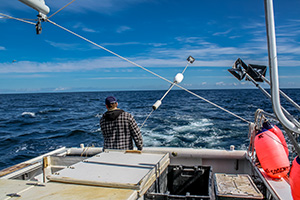 The Cooperative Gulf of Maine (GOM) Bottom Longline Survey is now underway for the fourth consecutive year. Two Massachusetts commercial longline fishing vessels and staff from the Northeast Fisheries Science Center’s (NEFSC) Cooperative Research Branch will be working in the Gulf of Maine over the next three weeks. They began staging October 5 on the 50-foot F/V Mary Elizabeth from Scituate and 40-foot F/V Tenacious II, which departed from Sesuit Harbor in East Dennis October 10 for the first of several two-to-four day trips. click here to read the story 14:28
The Cooperative Gulf of Maine (GOM) Bottom Longline Survey is now underway for the fourth consecutive year. Two Massachusetts commercial longline fishing vessels and staff from the Northeast Fisheries Science Center’s (NEFSC) Cooperative Research Branch will be working in the Gulf of Maine over the next three weeks. They began staging October 5 on the 50-foot F/V Mary Elizabeth from Scituate and 40-foot F/V Tenacious II, which departed from Sesuit Harbor in East Dennis October 10 for the first of several two-to-four day trips. click here to read the story 14:28
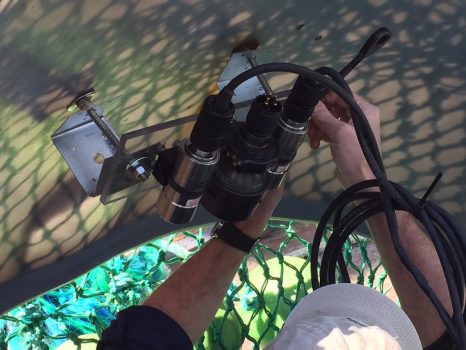
Live Cam May Show True Status of Atlantic Cod Fishery
Atlantic cod, New England’s most iconic fish, has been reported at historic lows for years, but fishermen hope a new video monitoring technique will prove there are more of the fish than federal surveyors believe. Ronnie Borjeson, who has been fishing for more than 40 years, says the federal surveys don’t match up with what fishermen are seeing. “I don’t care if you’re a gillnetter, a hook and line guy, a trawl guy,” he said, “there’s codfish everywhere up there. Everywhere. You can’t get away from them.” Borjeson helped test a video rig designed by researchers at the University of Massachusetts Dartmouth that allows them to record fish underwater and count them on the video later. With this rig, scientists can sample a larger area in the same amount of time and hopefully improve federal estimates of how many cod are left. click here to read the story 16:26
Counting Fish – A film by Don Cuddy click here to watch
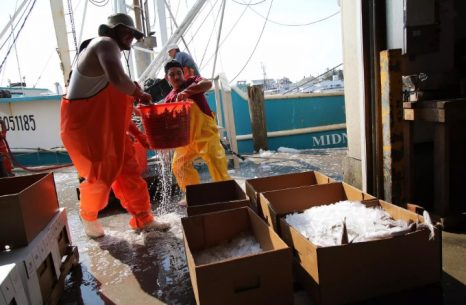
Something fishy in the quotas?
The clatter reverberated in the refrigerated cold as workers offloaded fish and wheeled full bins into a storage area on Fisherman’s Wharf. The catch was sorted, weighed, labeled, and eventually loaded onto large trucks headed for New York. It was a big haul, but not a big payday for Tom Testaverde Jr., captain of the Midnight Sun. “Our season’s been good. We caught a lot of fish, but the prices have been killing us all year,” Testaverde said. He pointed to imports that drive prices down, and regulations that limit what kinds of fish he can catch. Those federal limits on some species — particularly groundfish such as cod and flounder — are at odds with what commercial fishermen say they are seeing in the ocean. click here to read the story 14:34

Cooperation between fishermen, regulators not just a fluke
Fisheries management is only as good as the science that it’s based upon. The better the science, the more effective the management. For the past three years, Point Judith fisherman Chris Roebuck has partnered with federal regulators to get a better handle on fish stocks, taking scientists with the National Oceanic and Atmospheric Administration out to sea on his 78-foot Western-rig stern trawler the Karen Elizabeth to help figure out where groundfish are and in what numbers. This summer’s trip wrapped up this week when the team of five researchers led by John Manderson, a senior ecosystem field scientist with NOAA’s Northeast Fisheries Science Center, and a four-man crew headed by Roebuck returned to port in Galilee with new information on summer flounder, red hake and other species. click here to read the story 21:48
Bigelow won’t be around for the fall survey….who should do it? NEAMAP!
 NOAA’s Office of Marine and Aviation Operations, which operates and maintains the vessel, estimates that the ship will be back in service in early November, about two months later than originally estimated. In late July, a propulsion motor failed and the ship returned to port for repair, which was more extensive than initially thought and will require specialized parts. Several Northeast Fisheries Science Center research cruises have been affected. A beaked whale survey will be conducted later this year on the R/V Hugh Sharp, operated by the University of Delaware. The center is working with OMAO on options for using other NOAA ships for some or all of the annual fall bottom-trawl survey and the ecosystem monitoring cruise, which usually occur between September and late November. click here to read the story 14:30
NOAA’s Office of Marine and Aviation Operations, which operates and maintains the vessel, estimates that the ship will be back in service in early November, about two months later than originally estimated. In late July, a propulsion motor failed and the ship returned to port for repair, which was more extensive than initially thought and will require specialized parts. Several Northeast Fisheries Science Center research cruises have been affected. A beaked whale survey will be conducted later this year on the R/V Hugh Sharp, operated by the University of Delaware. The center is working with OMAO on options for using other NOAA ships for some or all of the annual fall bottom-trawl survey and the ecosystem monitoring cruise, which usually occur between September and late November. click here to read the story 14:30
Rhode Island Fishermen Express Concerns About Upcoming Stock Assessments And Fishing Limits
 Fishermen who attended a meeting Monday in Point Judith about upcoming groundfish stock assessments are unhappy with the data collection process for those assessments. The Northeast Fisheries Science Center, the research arm of NOAA Fisheries in the region, talked with commercial and recreational fishermen as a part of a series of port outreach meetings to hear fishermen’s concerns and to figure out how the science center could work to address them. Patrick Duckworth, a commercial fisherman who attended the meeting, said regulators are using bad scientific methods to collect data and set fishing limits. click here to read the story 08:43:52
Fishermen who attended a meeting Monday in Point Judith about upcoming groundfish stock assessments are unhappy with the data collection process for those assessments. The Northeast Fisheries Science Center, the research arm of NOAA Fisheries in the region, talked with commercial and recreational fishermen as a part of a series of port outreach meetings to hear fishermen’s concerns and to figure out how the science center could work to address them. Patrick Duckworth, a commercial fisherman who attended the meeting, said regulators are using bad scientific methods to collect data and set fishing limits. click here to read the story 08:43:52
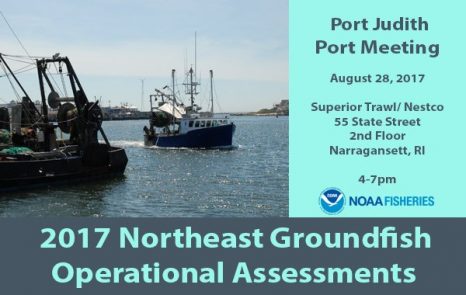
2nd Round of 2017 Groundfish Assessment Port Meetings Scheduled
The Northeast Fisheries Science Center is coming to a port near you! Join us for the second set of port meetings between August 28 and September 7 to discuss the upcoming groundfish operational stock assessments. These meetings will include an informal explanation of the stock assessment process, the cooperative research program, and ways that your concerns can be addressed by the science center. We’d like to talk to commercial and recreational fishermen. We’re listening to what you have to say. August 28-Narragansett RI, August 30-Montauk, September 6-Portsmouth, September 7- Plymouth. See the full schedule of confirmed meetings. Click here 16:27
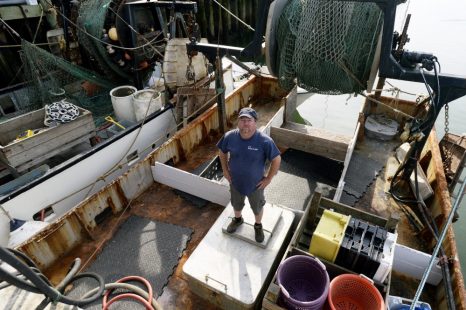
Maine fishermen, scientists combine forces with goal to save shrimp fishery
For more than 20 years, Dana Hammond made close to half his annual income shrimping. But his shrimping profits began to dwindle in 2013. That season, regulators were alarmed by the lack of shrimp biomass in the Gulf of Maine, and the amount he was allowed to catch was cut 72 percent. The fishery was closed entirely in 2014. It hasn’t reopened since and Hammond, who fishes out of Portland on his boat the Nicole Leigh, has been trying to make up the deficit from his other main source of income, groundfishing. But Hammond isn’t ready to let shrimping go. click here to read the story 09:22
Groundfish: NEFSC to Hold Port Meetings With Fishermen to Talk About Upcoming Assessments
 The Northeast Fisheries Science Center has scheduled a series of port outreach meetings to talk with commercial and recreational fishermen about the upcoming operational assessments for 20 groundfish stocks. Below is the list of confirmed meetings to date. August 15 in Chatham, 4 p.m, Aug. 16 in New Bedford, 4 p.m., Aug. 17 in Portland, Me. 3 p.m. Aug, 18 in Gloucester,10 a.m., Aug. 28 in Point Judith, 4 p.m. Aug. 30 in Montauk, Details to be announced. click here for locations, and more information The Groundfish Operational Assessments Peer Review is scheduled for September 11-15, 2017 at the science center in Woods Hole, MA. Additional information is available at NEFSC. Need to know more? Contact Stock Assessment Outreach Coordinator Ariele Baker at (508) 495-4741, [email protected].
The Northeast Fisheries Science Center has scheduled a series of port outreach meetings to talk with commercial and recreational fishermen about the upcoming operational assessments for 20 groundfish stocks. Below is the list of confirmed meetings to date. August 15 in Chatham, 4 p.m, Aug. 16 in New Bedford, 4 p.m., Aug. 17 in Portland, Me. 3 p.m. Aug, 18 in Gloucester,10 a.m., Aug. 28 in Point Judith, 4 p.m. Aug. 30 in Montauk, Details to be announced. click here for locations, and more information The Groundfish Operational Assessments Peer Review is scheduled for September 11-15, 2017 at the science center in Woods Hole, MA. Additional information is available at NEFSC. Need to know more? Contact Stock Assessment Outreach Coordinator Ariele Baker at (508) 495-4741, [email protected].
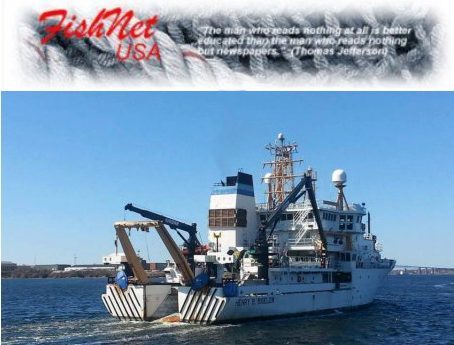
Trawl Surveys, what are they good for? – Nils E. Stolpe/FishNet USA
(Note that I am only addressing the NOAA/NMFS reliance on bottom trawl survey data in finfish stock assessments. I am not questioning the value of the wealth of biological and physical data that this long – running series of surveys generate.) From the article: According to NOAA/NMFS these surveys have provided and continue to provide “the primary scientific data” for fisheries assessments from North Carolina to Maine (fisheries assessments are the periodic – generally held every 3 to 5 years – scientific/bureaucratic exercises. In NOAA’s words “NOAA Fisheries’ scientific stock assessments are critical to modern fisheries management. Using data gathered from commercial and recreational fishermen and our own on-the-water scientific observations, a stock assessment describes the past and current status of a fish population or stock, answers questions about the size of the stock, and makes predictions about how a fishery will respond to current and future management measures.”) click here to read the article 12:35
How lobstermen gather temperature data from the bottom of the ocean
 A few decades ago, Jim Manning wanted to know what was at the bottom of the sea. And after years of studying waterways on the Atlantic coast, he says he’s seen a steady change in ocean temperatures that he calls ‘unprecedented.’ Manning is an oceanographer at NOAA’s Northeast Fisheries Science Center (NEFSC) in Woods Hole, Massachusetts. He partners with lobstermen on the Northeast Shelf from Maine to New York, attaching low-cost temperature and depth loggers to some of the millions of lobster traps deployed throughout New England. The project, called eMOLT (Environmental Monitors on Lobster Traps) records and plots . click here to read the story 09:31
A few decades ago, Jim Manning wanted to know what was at the bottom of the sea. And after years of studying waterways on the Atlantic coast, he says he’s seen a steady change in ocean temperatures that he calls ‘unprecedented.’ Manning is an oceanographer at NOAA’s Northeast Fisheries Science Center (NEFSC) in Woods Hole, Massachusetts. He partners with lobstermen on the Northeast Shelf from Maine to New York, attaching low-cost temperature and depth loggers to some of the millions of lobster traps deployed throughout New England. The project, called eMOLT (Environmental Monitors on Lobster Traps) records and plots . click here to read the story 09:31
Measuring flounder a complex undertaking with a big impact
 It’s likely few people have written more about summer flounder than Mark Terceiro. Terceiro has published a 44-page journal article about the science, politics and litigation surrounding the species from 1975 to 2000. A 32-page follow-up covered the period from 2001 to 2010, and another article regarding developments in recent years is in the works. But it’s Terceiro’s summer flounder stock assessment update, released by the National Oceanic and Atmospheric Administration in December, that has him in the crosshairs of New Jersey politicians and recreational fishing leaders. Terceiro, a research fishery biologist at NOAA’s Northeast Fisheries Science Center, said a lot of information goes into a stock assessment. “The catch is, from both commercial and recreational, very important — that it be accurate,” Terceiro added. “We try — the government, the states — (to) go to great lengths to make sure the catch reports are as accurate as they can get.” continue reading the article here 09:20
It’s likely few people have written more about summer flounder than Mark Terceiro. Terceiro has published a 44-page journal article about the science, politics and litigation surrounding the species from 1975 to 2000. A 32-page follow-up covered the period from 2001 to 2010, and another article regarding developments in recent years is in the works. But it’s Terceiro’s summer flounder stock assessment update, released by the National Oceanic and Atmospheric Administration in December, that has him in the crosshairs of New Jersey politicians and recreational fishing leaders. Terceiro, a research fishery biologist at NOAA’s Northeast Fisheries Science Center, said a lot of information goes into a stock assessment. “The catch is, from both commercial and recreational, very important — that it be accurate,” Terceiro added. “We try — the government, the states — (to) go to great lengths to make sure the catch reports are as accurate as they can get.” continue reading the article here 09:20
Northeast Fisheries Science Center director steers a new course
It was last Halloween when Jon Hare took over as Science and Research Director for NOAA’s Northeast Fisheries Science Center in Woods Hole. He was aware he was jumping into a cauldron but it hasn’t spooked him yet. “I knew it was going to be a challenge and that’s why I was interested in it,” the career NOAA scientist said. Hare does understatement well. The director’s job description includes managing “the living marine resources of the Northeast Continental Shelf Ecosystem from the Gulf of Maine to Cape Hatteras,” according to the NOAA website. If that in itself were not sufficient, these resources include commercial fisheries, and in New England that is synonymous with controversy. Federal fishery management in general, and the efficacy of NOAA’s survey work on fish stocks in particular, have been heavily criticized by fishermen in the Northeast, almost without cessation for the past 15 years and the NEFSC has been at the sharp end of much of this disaffection. Read the story here 20:22
took over as Science and Research Director for NOAA’s Northeast Fisheries Science Center in Woods Hole. He was aware he was jumping into a cauldron but it hasn’t spooked him yet. “I knew it was going to be a challenge and that’s why I was interested in it,” the career NOAA scientist said. Hare does understatement well. The director’s job description includes managing “the living marine resources of the Northeast Continental Shelf Ecosystem from the Gulf of Maine to Cape Hatteras,” according to the NOAA website. If that in itself were not sufficient, these resources include commercial fisheries, and in New England that is synonymous with controversy. Federal fishery management in general, and the efficacy of NOAA’s survey work on fish stocks in particular, have been heavily criticized by fishermen in the Northeast, almost without cessation for the past 15 years and the NEFSC has been at the sharp end of much of this disaffection. Read the story here 20:22
In Chesapeake Bay’s changing ecosystem, blue crab is king (and moving north)
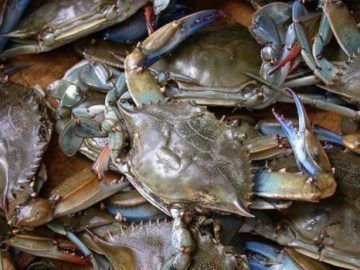 In the face of an evolving ecosystem, experts agree many of the differences in Chesapeake Bay marine life can – at least in part – be attributed to a worldwide warming trend. Over the last three decades, water temperatures in the Chesapeake Bay have increased about 1.5 degrees Celsius, or about 2.7 degrees Fahrenheit, said Rom Lipcius, professor of marine science at the Virginia Institute of Marine Science. The change means populations of many native sea creatures in the Chesapeake have moved or expanded north in search of cooler water temperatures, and other non-native creatures have moved in. As the warming trend continues, experts say some marine species will thrive as others struggle to survive in the face of temperature, environment and predator and prey changes. “It’s not all bad news, and it’s not all good news,” said Jon Hare, science and research director for the National Oceanic and Atmospheric Administration’s Northeast Fisheries Science Center. “There are both winners and losers in this situation.” There have been a number of species, including blue crab, scup and black sea bass, that have shifted or extended northward along the Atlantic coast, said Hare. Read the story here 08:35
In the face of an evolving ecosystem, experts agree many of the differences in Chesapeake Bay marine life can – at least in part – be attributed to a worldwide warming trend. Over the last three decades, water temperatures in the Chesapeake Bay have increased about 1.5 degrees Celsius, or about 2.7 degrees Fahrenheit, said Rom Lipcius, professor of marine science at the Virginia Institute of Marine Science. The change means populations of many native sea creatures in the Chesapeake have moved or expanded north in search of cooler water temperatures, and other non-native creatures have moved in. As the warming trend continues, experts say some marine species will thrive as others struggle to survive in the face of temperature, environment and predator and prey changes. “It’s not all bad news, and it’s not all good news,” said Jon Hare, science and research director for the National Oceanic and Atmospheric Administration’s Northeast Fisheries Science Center. “There are both winners and losers in this situation.” There have been a number of species, including blue crab, scup and black sea bass, that have shifted or extended northward along the Atlantic coast, said Hare. Read the story here 08:35
Fishermen and Scientists to collaberate on Trawl Surveys utilizing industry vessels in the Gulf of Maine
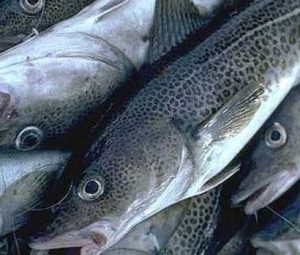 By next year, the Northeast Fisheries Science Center hopes to begin outfitting commercial boats with surveying equipment and paying fishermen to pull in catches that will supplement the regular trawl surveys conducted by government scientists, according to Russell Brown, who heads the center’s population dynamics branch. The gathered data will be fed into the complex process used to set catch quotas. It’s a collaboration that Brown hopes will give regulators a more detailed picture of the fish population and build trust among fishermen, who in turn see it as an opportunity to show the scientists what’s really going on. “It’s really perplexing that you’ve got a set of federal scientists who are sampling the ocean methodically and coming up with a very different picture than the fishermen about what’s going on out in the Gulf of Maine,” Jonathan Labaree of the Gulf of Maine Research Institute said. Read the story here 08:27
By next year, the Northeast Fisheries Science Center hopes to begin outfitting commercial boats with surveying equipment and paying fishermen to pull in catches that will supplement the regular trawl surveys conducted by government scientists, according to Russell Brown, who heads the center’s population dynamics branch. The gathered data will be fed into the complex process used to set catch quotas. It’s a collaboration that Brown hopes will give regulators a more detailed picture of the fish population and build trust among fishermen, who in turn see it as an opportunity to show the scientists what’s really going on. “It’s really perplexing that you’ve got a set of federal scientists who are sampling the ocean methodically and coming up with a very different picture than the fishermen about what’s going on out in the Gulf of Maine,” Jonathan Labaree of the Gulf of Maine Research Institute said. Read the story here 08:27
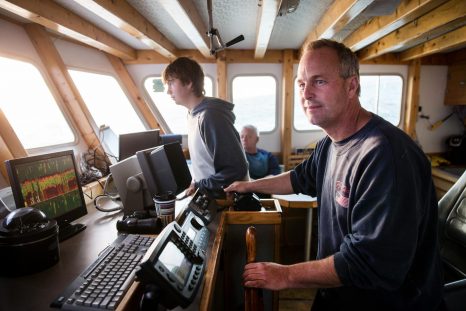
There are more fish in the sea – A high-tech battle for the future of the New England fishing industry
The high-tech battle for the future of the Massachusetts fishing industry is being waged aboard a western-rigged stern trawler named the Miss Emily. Onboard the commercial groundfish vessel, in addition to the satellite positioning system and other sophisticated tools that have become standard in the industry, are at least five computer monitors and a $14,000 fish-measuring board that has halved the time it takes to gauge the catch. State officials say it’s money well spent. Federal catch limits — caps on how many fish each boat can catch — have devastated the state’s most iconic commercial sector, fishermen say. In response to an outcry from the struggling local groundfishing industry, environmental officials are now using the Miss Emily to try to come up with a new — and, they say, more accurate — estimate of codfish in the Gulf of Maine. Under a survey launched last April, local fishermen hope new technology and an aggressive timetable will yield what they have concluded based on their own anecdotal evidence: There are more fish in the sea. Read the story here 09:59
Georges Bank said to be ‘paved with fluke! Fishermen Assail NOAA Quotas – Schumer fears major job losses
 Commercial fishermen on the draggers seen offshore last week took advantage of calmer seas and the State Department of Environmental Conservation’s raising of the daily limit on fluke from 70 to 210 pounds. The higher limit was in effect from Dec. 18 through Friday as the state’s annual quota for the fish, highly sought by commercial and recreational fishermen alike, had not been reached.,, Mark Phillips, who fishes on the F/V Illusion out of Greenport, was once among the largest harvesters of fluke in the state, landing a few hundred thousand pounds per year, by his count. The problem, Mr. Phillips said, is that stock assessments are inaccurate because NOAA conducts surveys — such as with its ship the Henry B. Bigelow, which collects data in waters from Maine to North Carolina — when fluke are migrating from undersea canyons to inshore waters. Read the story here 14:49
Commercial fishermen on the draggers seen offshore last week took advantage of calmer seas and the State Department of Environmental Conservation’s raising of the daily limit on fluke from 70 to 210 pounds. The higher limit was in effect from Dec. 18 through Friday as the state’s annual quota for the fish, highly sought by commercial and recreational fishermen alike, had not been reached.,, Mark Phillips, who fishes on the F/V Illusion out of Greenport, was once among the largest harvesters of fluke in the state, landing a few hundred thousand pounds per year, by his count. The problem, Mr. Phillips said, is that stock assessments are inaccurate because NOAA conducts surveys — such as with its ship the Henry B. Bigelow, which collects data in waters from Maine to North Carolina — when fluke are migrating from undersea canyons to inshore waters. Read the story here 14:49
Northeast Trawl Advisory Panel Members Witness Bigelow Survey Operations
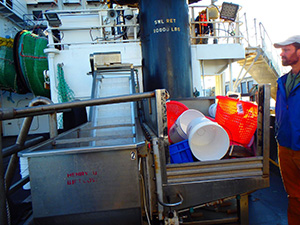 Three members of the Northeast Trawl Advisory Panel (NTAP), a new member of the New England Fishery Management Council and several of their colleagues made a day trip on the NOAA Ship Henry B. Bigelow October 11 to observe bottom trawl operations on the vessel, which is in the midst of the autumn bottom trawl survey. “The idea was to allow NTAP members to see how we operate under real survey conditions” said Rob Johnston, chief of the Northeast Fisheries Science Center’s (NEFSC) Ecosystems Surveys Branch. The group boarded the Bigelow early Tuesday morning, the first day of Leg 3 of the fall survey, at the Newport Naval Station in Rhode Island and headed offshore just south of Rhode Island Sound.,, “The trip on the Bigelow was very informative and answered many of the questions I had about the trawl mensuration system,” said Chris Roebuck, a fisherman from Pt. Judith, RI and a NTAP member. “The trip confirmed my belief that the survey is not at fault for the mismatches between what we see on the water and what comes out as an end result in management. Rather the interpretation of what that survey information means and how it is incorporated into management is to blame. The trip also made me realize that there are many more obstacles to overcome in our transition to industry vessels supplementing the Bigelow survey.” Read the story here 20:31
Three members of the Northeast Trawl Advisory Panel (NTAP), a new member of the New England Fishery Management Council and several of their colleagues made a day trip on the NOAA Ship Henry B. Bigelow October 11 to observe bottom trawl operations on the vessel, which is in the midst of the autumn bottom trawl survey. “The idea was to allow NTAP members to see how we operate under real survey conditions” said Rob Johnston, chief of the Northeast Fisheries Science Center’s (NEFSC) Ecosystems Surveys Branch. The group boarded the Bigelow early Tuesday morning, the first day of Leg 3 of the fall survey, at the Newport Naval Station in Rhode Island and headed offshore just south of Rhode Island Sound.,, “The trip on the Bigelow was very informative and answered many of the questions I had about the trawl mensuration system,” said Chris Roebuck, a fisherman from Pt. Judith, RI and a NTAP member. “The trip confirmed my belief that the survey is not at fault for the mismatches between what we see on the water and what comes out as an end result in management. Rather the interpretation of what that survey information means and how it is incorporated into management is to blame. The trip also made me realize that there are many more obstacles to overcome in our transition to industry vessels supplementing the Bigelow survey.” Read the story here 20:31
NOAA Appoints Dr. Jon Hare New Director of Northeast Fisheries Science Center
 NOAA announced the appointment of Jonathan A. ‘Jon’ Hare, Ph.D. as the new Science and Research Director for NOAA’s Northeast Fisheries Science Center. As director, Dr. Hare will continue the work of planning, developing, and managing a multidisciplinary program of basic and applied research on the living marine resources of the Northeast Continental Shelf Ecosystem from the Gulf of Maine to Cape Hatteras, NC. He will lead NOAA Fisheries’ five northeastern labs and field stations. Dr. Hare will officially assume his new role starting October 31, 2016. Dr. Hare has held various positions with NOAA Fisheries for more than two decades, winning multiple awards for his leadership and administrative capabilities, as well as for his research. Most recently, he served as Supervisory Research Oceanographer and Acting Ecosystems Processes Division Chief for the NEFSC Narragansett Laboratory. In this role he managed division research while also managing personnel and research resources for five different locations in the center. Link 16:40
NOAA announced the appointment of Jonathan A. ‘Jon’ Hare, Ph.D. as the new Science and Research Director for NOAA’s Northeast Fisheries Science Center. As director, Dr. Hare will continue the work of planning, developing, and managing a multidisciplinary program of basic and applied research on the living marine resources of the Northeast Continental Shelf Ecosystem from the Gulf of Maine to Cape Hatteras, NC. He will lead NOAA Fisheries’ five northeastern labs and field stations. Dr. Hare will officially assume his new role starting October 31, 2016. Dr. Hare has held various positions with NOAA Fisheries for more than two decades, winning multiple awards for his leadership and administrative capabilities, as well as for his research. Most recently, he served as Supervisory Research Oceanographer and Acting Ecosystems Processes Division Chief for the NEFSC Narragansett Laboratory. In this role he managed division research while also managing personnel and research resources for five different locations in the center. Link 16:40
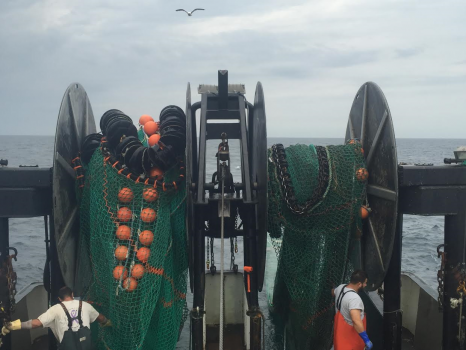
A Clean Sweep On The Ocean Floor
Most of the reporting in the media about commercial fishing and declining stocks in the Northeast dwells on how dire the situation has become with the fault generally attributed to fishermen and “overfishing.” The view on the waterfront is very different however. Fishermen have long maintained that there is a huge disconnect between what they see on the water and the conclusions derived from the NOAA surveys and stock assessments. Their claims have been dismissed as self-serving. Now it seems the fishermen have a strong case. On a recent bottom trawl survey, a typical industry net caught four times as many flatfish as the rig used on the government trawl surveys. Written by Don Cuddy, program director at the Center for Sustainable Fisheries Read the story here 17:17
Northeast Fisheries Science Center is looking for one to three commercial trawl vessels
 Northeast Fisheries Science Center (NEFSC) is seeking 1 – 3 commercial trawl fishing vessel partners to participate in a project related to NEFSC bottom trawl survey operations The goal of the project is to help assess the potential for collaborative industry-based trawl sampling to contribute to stock assessments of commercially important fish populations in waters of the Northwest and mid-Atlantic ocean. The project will investigate the use of industry vessels to supplement NEFSC survey sampling, and/or provide survey coverage if the FSV Bigelow is unavailable or competing uses restrict its availability for the standardized NEFSC bottom trawl survey. One to three vessels will be selected to help assess the capability of industry vessels to provide the standardized tow dynamics required to supplement the existing federal bottom trawl survey conducted on the FSV Bigelow. Read the notice, check the specs here 09:21
Northeast Fisheries Science Center (NEFSC) is seeking 1 – 3 commercial trawl fishing vessel partners to participate in a project related to NEFSC bottom trawl survey operations The goal of the project is to help assess the potential for collaborative industry-based trawl sampling to contribute to stock assessments of commercially important fish populations in waters of the Northwest and mid-Atlantic ocean. The project will investigate the use of industry vessels to supplement NEFSC survey sampling, and/or provide survey coverage if the FSV Bigelow is unavailable or competing uses restrict its availability for the standardized NEFSC bottom trawl survey. One to three vessels will be selected to help assess the capability of industry vessels to provide the standardized tow dynamics required to supplement the existing federal bottom trawl survey conducted on the FSV Bigelow. Read the notice, check the specs here 09:21
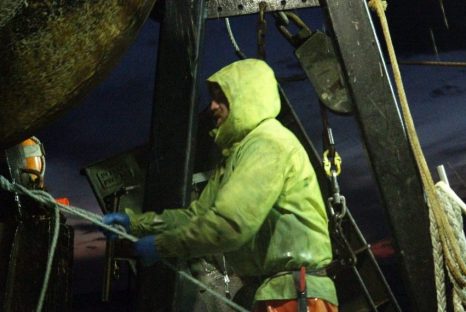
Transition to industry based surveys approved by NOAA. At last!
The announcement from NOAA on Tuesday that they will begin to transition the Northeast Fisheries Science Center’s bottom trawl surveys from their research ship, the Henry B. Bigelow, to fishing industry vessels is a cause for celebration on the waterfront and represents a real opportunity to get the fishing industry in New England out of disaster mode. It is a bold decision but it is undoubtedly the correct one and, from an industry perspective, one that is long overdue. Science Center director Dr. Bill Karp deserves enormous credit for setting this process in motion. It is a clear signal that NOAA wants to build trust and transparency, qualities that have not always been in evidence in its long and difficult relationship with the commercial fishing industry in New England. Read the rest here 13:15


































